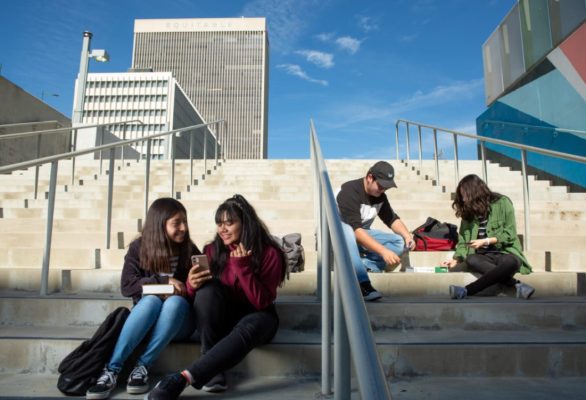UCLA Center for Community Schooling Research-Practice Partnership Brief
Supporting College Persistence: Lessons from a College Transition Class
December 18, 2023
Introduction
Attending college to attain a degree is a quintessential part of the American Dream for many immigrant students, and Andrew Flores is no different. After graduating from the UCLA Community School in 2014, Andrew enrolled at UCLA and earned both a B.A. and an M.A. in Latin American Studies. He is now a special education teacher, back at his alma mater. Though Andrew’s journey is an incredibly inspiring example of college persistence, his success was not easy, and certainly not inevitable.
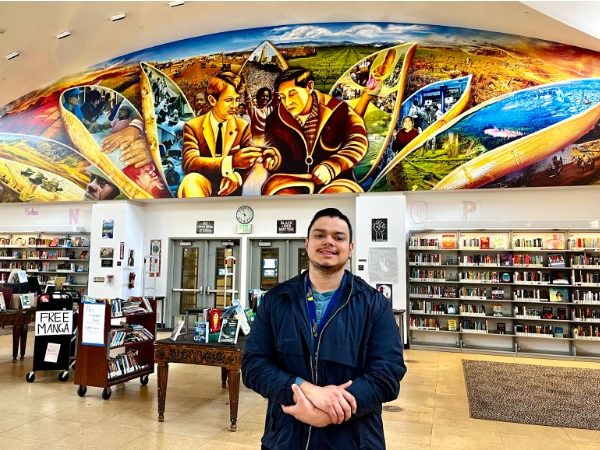
In the United States, first-generation students of color face numerous barriers in not just accessing higher education, but also completing college. The most recent data from the National Student Clearinghouse (2023) reveal that only 28% of students from low-income, high-minority schools complete college within six years, compared with 52% of students from higher-income, low-minority schools. In 2020, the UCLA Center for Community Schooling released a report focused on this issue. In Creating Persistent Community: The Challenge of Aligning Supports for First-Generation College-going Students, researchers report on the experience of seven cohorts of students (n=597) from the UCLA Community School and track their pathways to and through college. Findings show that UCLA-CS alumni have high levels of immediate college enrollment and first to second-year persistence, at 81% and 80% respectively, which are both higher than the respective national rates of similar schools. However, the 6-year college completion rate remains low at 31% (Quartz et al., 2020). In response, the report recommends that schools recognize the challenges their alumni face and prepare current high school seniors to understand and navigate these challenges by belonging to a persistent community of supporters.
In this research brief, we respond to this recommendation as part of a longstanding Research Practice Partnership (RPP) to study and improve the UCLA Community School’s college going culture. As undergraduate research interns at the school, we co-designed, taught, and studied a culturally-responsive college transition curriculum to support first-generation students’ development of college navigation knowledge and skills, critical consciousness, and connections with family and community during their college journey. This RPP Brief highlights mentorship practices and lessons learned, in hopes of informing how higher education institutions can strengthen partnerships with K-12 schools to support the college transition of first-generation students of color.
Literature Review
Structural Challenges
Low college persistence rates may be attributed to the range of structural challenges that students of color face in college. Navigating postsecondary educational pathways comes with many potential difficulties, which include academic adjustment, dealing with academic failure, gaps in college attendance, feeling pressure to succeed, and finding institutional and familial support (Quartz et al., 2019). Moreover, many high schools tend to favor the dominant capital of White middle-class students as the accepted standard for success in academics and college attainment (Bourdieu, 1977; Freeman, 1997; Lareau and Horvat, 1999; McDonough, 1997). Schools, at times forcefully, assimilate students of color through policies and practices that strip them of their cultural and social assets, in a process known as ‘‘de-capitalization’’ (Putnam 1993, 1995, as cited in Valenzuela 1999, p. 21).
As a result, students of color have historically faced additional barriers to college access and are not privy to the unwritten rules of high school that are essential for connecting them to important college preparatory resources (Dumais & Ward, 2010; Freeman, 1997; McDonough, 1997 as cited in Welton et al., 2014). Some of the common barriers that first-generation students of color face in particular include a lack of understanding of available financial resources, inadequate preparation for college-level work – including computer literacy, time management, and study skills, lack of intrinsic motivation, and a sense of isolation as a result of experiencing racism (Dulabaum, 2016).
Culturally-responsive Teaching and Mentorship
Since students of color have been given inequitable access to information and guidance to realize their college aspirations and successfully navigate their transition to college (Duncheon & Relles, 2019; Holland, 2017; Hooker & Brand, 2010; Kurlaender et al., 2019), educational institutions can and should play a bigger role in bridging the gap to support the success of its students. We share how this can be done in this study.
Prior research has shown that in high school contexts, mentors who motivate students and share effective knowledge about college through trusting and authentic relationships, and college outreach programs are vital social networks that assist students along the pipeline to college (Levine & Nidiffer, 1996; McDonough, 1997; Stanton-Salazar, 2001; Stanton-Salazar & Spina, 2000 as cited in Welton et al., 2014). Though college counselors are a valuable resource for students, their high caseloads mean that they have limited bandwidth to address all the individual needs of the diverse student population they serve (Welton et al., 2014). Hence, undergraduate student mentorship enables students to forge a natural personal relationship with high school students, and serve as role models by sharing their college experience through teaching from past and current experiences (Jacobi, 1991, as cited in Puzzar et al., 2019). Through this mentorship relationship, students can learn college knowledge on the ‘‘complex college admission and selection processes, the options available to help for postsecondary education, the academic requirements for college-level work, and the cultural differences between secondary and postsecondary education’’ (p. 77), which strengthens their college-going identity (Welton et al., 2014).
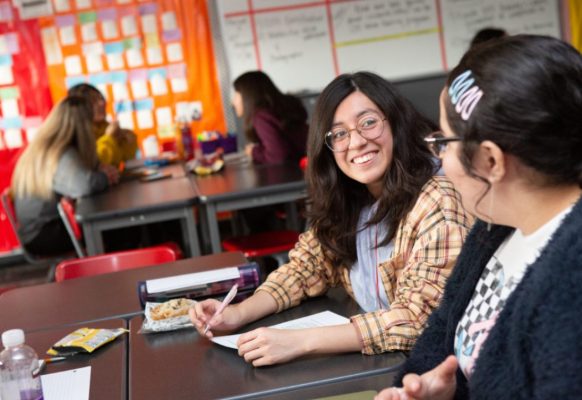
Furthermore, a culturally-responsive college readiness and access approach is best suited to serve students of color (Castro, 2013; Perez et al., 2021; Welton & Martinez, 2014). culturally-responsive teaching is defined as using the prevailing cultural characteristics, experiences, and perspectives of ethnically diverse students as conduits for teaching them more effectively. This teaching framework situates content knowledge within students’ lived experiences and frames of reference to enhance its meaningfulness and relatability (Gay, 2002). An example of using a culturally-responsive lens includes affirming the rich community cultural wealth that students of color possess, which they can utilize to tenaciously navigate complex, inequitable educational terrains that were not designed for marginalized groups of students.
Research Question
With the design and implementation of this college transition class, we hoped to define culturally-responsive mentorship as implemented in the classroom, and investigate its influence on students’ preparedness for college. Our work was guided by the following research question: What is culturally-responsive mentorship and how does it influence the college readiness of first-generation students’ of color?
Researcher Positionality
We come to this project with different positionalities as a team of undergraduate researchers. Our unique perspectives and experiences with the world are our own, but when put together, they guide us in our research. Our positionality as aspiring educators, some of us also being first generation, allows us to understand the issues around college access and completion and hopefully inspire change. As detailed above, culturally-relevant mentorship frames our scholarship and lifts up what we each bring to this study. As Milner (2007) discusses, “guides and frameworks are needed to (a) contribute to and extend the discourse about researchers’ roles, responsibilities, and positionality; (b) assist and empower researchers in the process, production, and outcomes of inquiry; and (c) hold researchers more accountable to the communities and people with whom they conduct research” (Milner, 2007, p. 389).

Jonathan Oyaga is a fourth-year undergraduate student majoring in Education and Social Transformation. He is also a first-generation transfer student from Pasadena, CA and the son of Guatemalan and Colombian immigrants. He has worked with students of all ages and privileges (or lack of) and works in community organizing and education advocacy as president of the Student California Teachers Association.

Elsie Paulsen is a third-year undergraduate student double-majoring in Public Affairs and Education and Social Transformation. She has a passion for educational equality and education policy. She is from Encinitas, California and comes from a family of dedicated educators.

Sarahy Torres is a first-generation, low-income undergraduate student majoring in Chicana/o Studies and Education and Social Transformation. She is from Oxnard, CA, and the daughter/granddaughter of hardworking Mexican farmworkers.

Chia Ying Wong is a second-year undergraduate student double majoring in English and Education and Social Transformation. She is an ethnically Chinese Singaporean and has worked with underserved students from marginalized backgrounds in numerous volunteering and mentorship capacities.
Methods
In this study, we used a qualitative case study methodology, which essentially explores ‘‘a bounded system through detailed, in-depth data collection involving multiple sources of information, and reports a case description and case-based themes” (Cresswell, 2013). This design is well-suited for our study’s intended purpose of gaining an in-depth understanding of how college-responsive mentorship was implemented specifically in the UCLA Community School, as well as how that mentorship influenced first-generation students’ readiness for college.
School and Classroom Context
This research-practice partnership (RPP) took place at the UCLA Community School, one of six schools at the Robert F. Kennedy Community Schools complex. The campus serves low-income students and their families, primarily immigrants from Mexico and Central America. The school reports at least 90% of the student body identify as first-generation college students. Since the idea came about to start the school in 2006, and finally when it was founded in 2009, UCLA has worked with the community to support its students and their families. RPPs are collaborations between practitioners and researchers to address practice problems and develop solutions to improve schools and school districts (Coburn et al., 2013). All RPPs at the school are designed to inform practice, ensure accountability, and create new knowledge (Quartz et al., 2017).
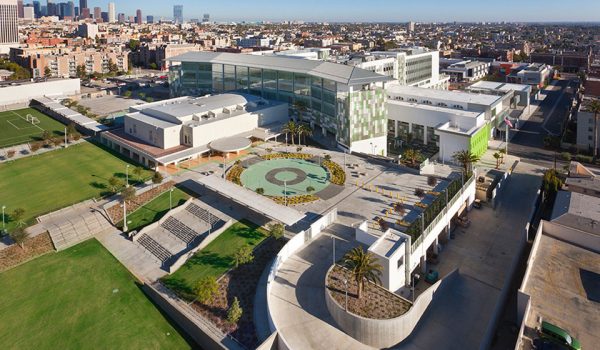
Our study took place in the context of a college class created during the pandemic to establish dedicated time for the school’s college counselors to support students throughout the college admissions process. After the return to in-person instruction, the college class was primarily used as a study hall for students where they could work on their college applications or receive support on college-related tasks, such as filling out their Free Application for Federal Student Aid (FAFSA) and writing supplemental college essays. Due to the fluid nature of the class, it was common for counselors and administrators to pull students out of this class for other matters. As part of the RPP, this class was identified as an opportunity to explicitly address and prepare students for the transition to college. We worked with UCLA research partners, Ariana Dimagiba and Karen Hunter Quartz, and the school’s college counseling team, Andrea Jaime, Brianna Rosas, Beth Trinchero, Agnes Cesare, and Rebekah Kang, to co-design, teach, and study a college transition class. Together, we developed and piloted a culturally-responsive college transition curriculum for the 2023 Spring semester.
We began delivering instruction in the middle of February and continued until the end of the school year. The class was separated into two units. The first unit was titled: College-Going Identity & Critical Consciousness. This unit identified systemic barriers that first-generation students of color may face in higher education. The first unit also aimed to aid students in recognizing their own unique identity, culture, support system, and abilities and help students understand that they have skills that will be valuable in college. The second unit was titled: Finessing College: Strategies and Resources for Successfully Navigating College. In this unit, we provided students with information about class schedules, college resources, clubs, dorming and academic expectations to help students feel confident that they can navigate systems of higher education. Most of the lessons taught in the class included a lecture on relevant content followed by an interactive activity. As undergraduate mentors, we prioritized including time for cultivating relationships with the students and providing students with opportunities to ask us specific questions.
There were two different class periods for the college transition class, period 1 and period 4. Chia Ying and Elsie taught 37 students in period 1, on Wednesdays from 8:30 to 10:20am. Sarahy and Jonathan taught 16 students in period 4, on Thursdays from 8:30 to 10:20am.
Data Collection and Analysis
Throughout the college transition course, data collection was conducted in addition to the development of the curriculum and instruction. First and foremost, student artifacts were made and collected throughout the course, including college journey maps, mentimeter results, and self-assessments. Furthermore, we utilized our eight lesson plans, 68 pages of planning notes from 23 meetings from February to May, and 24 teaching journal entries as data. With all the data collected, we then developed a scheme to code and sort through all the data.Taking inspiration from the coding process discussed in Saldana (2013), we went through a systematic process of coding and created data matrices to discuss emerging themes. To develop the coding scheme, we focused on our research question to identify instances where culturally-responsive mentorship by college undergraduate students influenced the college readiness of first-generation students of color. We identified four parent codes and refined our codes after going back and forth with the data in discussion over the course of three weeks. Based on our data, the following themes emerged: Opportunities To Learn, Teaching and Mentoring, Learning Outcomes, and Cultural Tensions.
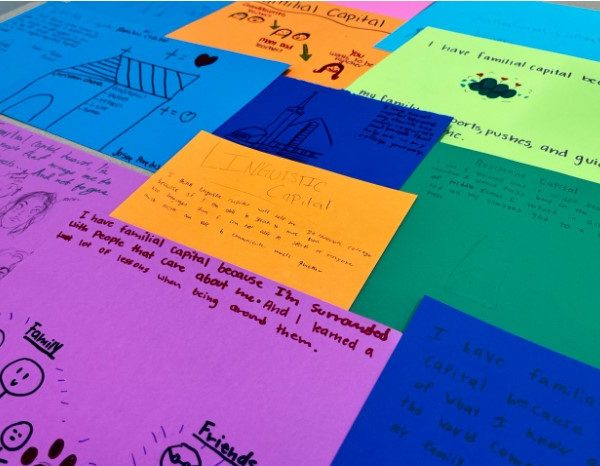
In our data analysis, each research team member coded student artifacts, lesson plans, planning notes, and teaching journals. As a team, we learned about and developed our own code book, beginning the coding process together on a few lesson plans and teaching journals. Once we solidified our codebook, we coded each other’s teaching journals. Interns that were part of period one coded period four’s journals, and vice versa. Lesson plans were randomly assigned to be coded to all the interns, as well as sections of the planning notes and artifacts. Due to time constraints, all data was only coded once. We acknowledge that this may affect the validity and recommend that if the study were to be repeated, several more rounds of coding be conducted. Once all data was coded, we identified patterns and frequencies to help us understand our findings.
Findings
The primary goals of the two-unit class were to help students develop a critical consciousness about what it means to be a first-generation student of color and to provide in-depth college knowledge and resources to prepare students for their future educational journeys. Here, we share our findings about how culturally-responsive mentorship was implemented in the class and how that contributed to students’ learning outcomes.
Culturally-responsive Mentorship
Through our experiences, we found three dimensions of culturally-responsive mentorship: personal relationships, cultivating consciousness, and college knowledge. The following sections describe these themes in depth based on our class notes, lesson content, and student materials.
Personal Relationships
The first dimension of culturally-responsive mentorship that arose through our teaching was the development of personal and genuine relationships with students. Undergraduate student mentorship fosters an environment for authentic connections as mentors can share personal experiences and advice regarding college, everyday struggles, and life in general (Jacobi, 1991). There is evidence that when relationship-building is prioritized and successful, some students of color can defy the odds and build rich social networks that promote persistence in education (Stanton-Salazar, 2001). Building personal relationships and trust encourages students to engage with our advice and knowledge and develop a thorough understanding of critical consciousness and college knowledge. We cultivated a personal connection-based classroom by acknowledging past mistakes and rejections, sharing narratives of our stories, and periodically checking in on students. In addition, two of us are first-generation students of color and were able to shed light on our own experiences to help students understand what it means to be a first-generation student of color. The fact that we are all current college students also helped build trust and rapport. We found evidence that the students valued having undergraduates as their mentors. For example, in a focus group interview, one student said, “I think it was beneficial to have actual college students because they just know the process. They know how things work”. This quote affirmed that our close connection to college increased the student’s trust in us and believed our advice was reliable and applicable.

We nurtured mentorship relationships during lesson presentations and while the students worked independently during class. During lesson plans we shared advice such as, “Do not be afraid of rejection” when students apply for scholarships. As the students started to receive college admissions decisions, we made it a goal to affirm that “these [rejections] are redirections and not failures and that there are still many possibilities/opportunities that await them further down the road.” One of us noted this goal in their teaching journal and explained that through advice and personal connections they transformed the idea that rejection was entirely negative. We framed the curriculum through an assets-based lens. Consequently, we prepared our advice and personal interactions with the students through an asset-based lens to uplift the students and recognize their capital.
A vital benefit of our mentorship was the ability to provide personalized advice about particular questions or circumstances that students were experiencing, which included their college choices, choosing specific majors from college websites, and reviewing draft scholarship essays. We would give advice not only on content information but on students’ decisions on colleges. As noted in a teaching journal, one of us provided insight on the difference between community colleges and 4-year institutions to a student deciding which path was best for them. The mentor had already established a personal relationship with the student, making the student comfortable and willing to ask for advice. Another mentor mentioned in his teaching journal that he was able to talk through college options with a student who was deciding between a large public university and a private liberal arts college. The mentor’s brother happened to attend the liberal arts college, so he was able to provide inside information and advice to the student. Students may not have felt comfortable confiding in us for advice without personal relationships. As most of the students are first-generation, we found it even more vital to establish connections with them since they already have a limited number of people in their support circle who can advise them on the complexities of higher education.
Cultivating Critical Consciousness
The second dimension of culturally-responsive mentorship was cultivating critical consciousness. During Unit 1, we focused on having students critically reflect on their positionality as first-generation students of color. Perez et al. (2021) define critical consciousness as the ability of students of color to (1) form relationships with students who are like-minded and can support them, (2) achieve despite stereotype threat, and (3) prepare themselves for microaggressions and other harmful interactions that they may experience as ethnic minorities (Perez et al., 2021, p. 5).
One of our lessons asked about students’ life goals and their family’s educational aspirations. These conversations led to topics like race and its role in how students of color experience college. Utilizing our social networks, for example, one of us connected their brother with a student to talk about his experience as a Latino male attending an out-of-state predominantly White institution (PWI), sharing, “In Los Angeles, you don’t have to try to be Latino. But in Snowball (a pseudonym) University, you must remember that you are because you’re constantly advocating for yourself, and you don’t see yourself anywhere.“ After the conversation, the mentor and student discussed the culture shock the student would experience if he committed to the private PWI. The student had to consider whether it was worth subjecting himself to the daily struggle to self-advocate for his needs in every space at the private PWI.

In addition to this student’s experience, another student had a similar experience at a local private college. The mentor speaking to this student wrote in her teaching journal, “She [student] felt like a minority, especially when the tour guides were separating the students from the parents, and she had to go with her mom and translate for her.“ This student felt alienated and recognized her identity in an admitted school tour of the private college when she had to translate for her mom in a group of adults. We shared with students, in individual conversations, that direct and indirect racist experiences and the lack of support for students of color have always been part of our experience and will continue in college. As a result, we shifted our focus from institutional racism to community cultural wealth (CCW) as a way for students to recognize and utilize their assets. CCW is a response to institutional racism and acts as a resistance strategy that first-generation students of color can use as agents in their lives (Yosso, 2005).
As a foundational piece in cultivating students’ critical consciousness, we presented a lesson on the history of racism in higher education and community cultural wealth. CCW challenges traditional interpretations of cultural capital and redefines it through the skills students of color bring into academia in six forms: aspirational, navigational, social, linguistic, familial, and resistant (Yosso, 2005). These lessons and sharing our own experiences allowed for rich conversations with students about navigating institutional racism in college. These instances and many others in the classroom expressed the importance of teaching students community cultural wealth capitals. Gay (2002) explains that using a culturally-responsive lens affirms rich community cultural wealth that students of color possess, which they can utilize to navigate spaces not meant for marginalized students. For example, many students recognized their bilingualism and trilingualism as essential linguistic skills in navigating higher education spaces.
Students in both classes were able to cultivate critical consciousness to help guide them as first-generation students of color in higher education. In the self-assessments, one student mentioned, “An educational struggle I have somewhat faced was the issue of having to fill out the FAFSA and it being a bit confusing to work through. I overcame it by asking my brother for assistance.” Another student shared, “I was not sure how to write my essays for college apps. I had help from people I knew at church, and they were also able to connect me with others”. Both students realized they used familial, social, and navigational capital to navigate college applications and finances. During focus groups, students mentioned identity clubs in college being vital to them, “I think it’s important for me to relate to people because they have similar experiences.”
We also analyzed student artifacts for evidence that the students in both periods took formative steps toward developing their critical consciousness about college. To build up students’ critical consciousness, we created a community cultural wealth worksheet that students completed, demonstrating their understanding. In addition, by the end of the first unit, many students could identify which capitals they possess. For example, one student noted, “I have aspirational capital because I aspire for good things in my future.” Another student commented, “I have familial capital because my family is always there for me and is my biggest supporter.” The lessons and activities the students participated in led them to develop their critical consciousness about college. Their critical thinking allowed them to be open about college knowledge and the resources they need to persist in academia as first-generation students of color.
College Knowledge
As part of the college transition curriculum, we gave students insight into the world of college by exploring multiple facets of higher education. From sharing about the different types of resources and benefits of being a student, how to effectively manage one’s time, how to make friends and explore interests, we wanted to give our perspectives and more to help students be better prepared for college. Kurlaender et. al (2019) claim that four factors are key to educational attainment and one of those is knowledge and information. However, the report further discusses how first-generation students and students of color lack access to “quality” information.
To address this issue, we shared the hidden curriculum around going to college, which is the skills and knowledge not necessarily taught in school, or at least not directly stated, to help students succeed. Much of the hidden curriculum about going to college was covered in Unit 2 and revolved around building students’ agency in persisting through college through culturally-responsive lessons. We helped develop student agency by constantly reminding students that they are their advocates in higher education and, therefore, must take the agency to succeed. To do that, we included this hidden curriculum in the lesson planning and one-on-one interactions with the students.
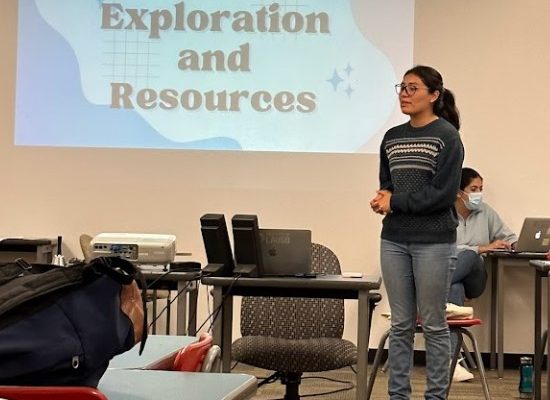
One example of college knowledge is found in Unit 2, Lesson 3 when Sarahy discussed her experience increasing her cost of attendance to receive reimbursements and keep her scholarships. She shared that she could do this by asking many questions and following up with financial aid services. She further discussed how maintaining a relationship with a financial aid officer helped her navigate this situation to avoid losing money due to her over-award. She stressed how this was only made possible because of the agency she took to familiarize herself with the financial aid office staff and advisors. In this example, students were encouraged to communicate their financial needs and utilize their capital to navigate the financial aspects of higher education.
Another example of developing college knowledge was our focus on finding jobs and budgeting for higher education. As a first-generation student who financed his education, Jonathan shared his experience with work-study and its limitations. He shared how work-study jobs are desirable because they are less labor-intensive and sometimes allow you to work on homework while on the clock, but how hours are limited. Discussing how he had to budget for rent, bills, and life expenses, he showed how work-study jobs might not necessarily help make ends meet. This discussion was held during Unit 2, Week 3, where we discussed other college financing methods, such as scholarships and loans. At the same time, Jonathan discussed his higher education journey as a community college transfer student and how it helped him save money to persist through his last two years of college at UCLA. He explained that although it was not his desired route, it helped him become a better college student regarding study habits and time management.
Also, in Unit 2, students were introduced to roleplay and case study activities to find solutions to common circumstances they might find in college. In the roleplay activity, students were guided to make friends in class and coached on creating study groups. In these activities, students demonstrated their ability to communicate with their peers to make friends or collaborate on assignments in their first semester/quarter in college. The students also participated in a case study activity where they found solutions for a student who just failed an exam. In one group in period 4, students quickly utilized their college knowledge to inform the student in the case study to go to office hours, seek peer support, or sign up for tutoring sessions through academic support centers on campus.
These are prime examples where college knowledge was carefully crafted into the curriculum to support students in their transition to college. Since information is an essential determinant of students’ educational pathway (Kurlaender et al., 2019), our curriculum bridges the barriers to information access and quality that low-income first-generation students of color face and develops students’ understanding and skills to successfully navigate the financial, academic, and social-emotional aspects of college life.
Reflections on a College Transition Class
Given the challenges that first-generation students of color face in accessing and persisting through higher education, it is imperative that educational institutions invest in programs and resources to prepare students for this transition. Here, we reflect upon how our own positionality shaped the class and share recommendations or takeaways about how similar programs can be improved in the future.
Understanding the Impact of Socio-Economic Positionality on Mentorship
Elsie: As a White woman whose parents both attended college, I went into the college transition class knowing I was not going to be able to relate to the majority of the students’ experiences. I was most often the only White individual in the classroom and I had my parents to offer advice and support through my college transition process, so I was nervous I would have trouble connecting to the students. I found that by creating relationships with students and actively practicing empathy I was still able to offer support and guidance even if I could not relate to their experiences.
Sarahy: As a college student who is the first in my family to attend, I had much in common with most students. It was reassuring to discover that they understood the struggles of being a Latina/o and the lack of representation in various fields. Although we all shared similar cultural backgrounds, our upbringings were quite different. I grew up in a suburban/rural area and am accustomed to living in the unincorporated parts of my hometown. Despite our varying backgrounds, I learned from my students about their experiences living in the city and the valuable knowledge they brought to our classes. Through these connections, I became a key part of their decision-making process regarding choosing a college.
Chia Ying: As an international student, I was determined to put in extra effort to read up on the educational landscape in the United States, to fill in my knowledge gap about the different systems and procedures for accessing various post-high school pathways. While I have prior experience teaching in various learning settings to students from diverse backgrounds, I have not specifically worked with a class of this particular age group and racial demographic. This class reinforced my belief that teaching is a deeply personal endeavor; while I may not share entirely identical experiences as the students, I strove to build strong connections with the students through active listening, reaching into our common humanity, and opening my mind and heart to learn about their unique perspectives and lived experiences.
Jonathan: As a first-generation student of color and aspiring educator, mentoring these students was an honor and privilege as I provided them with information I wish I knew when I was in their shoes. I found that because my struggles and challenges were similar to those of the students, I was able to build a stronger relationship with them through the personal anecdotes and advice I had to share. Being a transfer student also helped in building rapport with the students as I actively battled the community college stigma in conversations about higher education. Sharing the struggles that forced me to enroll in my local community college, I also uplifted the lessons learned, further explaining how community college helped me develop my critical consciousness and helped me develop the skills I needed to succeed at UCLA. Sharing about my experiences on how I overcame the obstacles I faced became a crucial part of the relationship building process and in strengthening mentorship outcomes.
Challenges
This section discusses the many difficulties we overcame during the class implementation process. Since the class was conducted in the first period early in the morning, keeping students engaged was the main challenge that we faced, especially since some of us lacked prior teaching experience and training. Other challenges included typical classroom behaviors of being distracted or using technology.
During the class implementation, various unexpected interruptions affected the curriculum structure, including the resignation of the college transition class teacher and the lack of a replacement throughout the rest of the year, field trips, and Advanced Placement testing, which prevented students from being in class for some of the lessons.
As a result, we needed to find ways to keep students updated on lessons they had missed, which included providing short summaries and making the presentations available so they could review the slides at any time. Through experimenting with different lesson activities, we found that students were “a lot more engaged and receptive to interactive games-based competitive activities” like Kahoot, media content like videos, and hands-on activities like the letter-writing activity to their circles of support.
Reciprocal benefits
While the UCLA Community School benefited from our mentorship, we also gained a lot through this partnership. Through our internship class, we were given the rare opportunity to step outside the college campus and intimately understand the history and workings of a community school. We learned key lesson-planning strategies and pedagogies to enhance the effectiveness of our mentorship, practiced our research methodology skills by assisting in facilitating focus group discussions, and even presented our independent project during UCLA’s undergraduate research week, thanks to the strong guidance of a graduate student and faculty mentor.
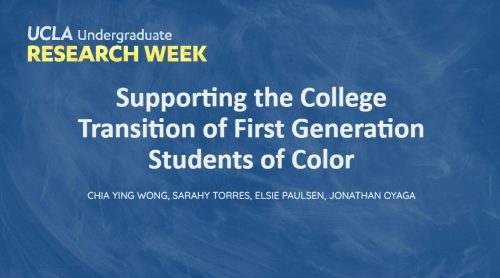
Some of our takeaways include how to more strategically allocate time to specific activities, learning to be flexible and deal with unexpected circumstances, prioritizing personal time to get to know the students, and providing more scaffolding for learning. One mentor remarked, “I think we have gotten a lot more comfortable with using strategies to engage the class better. For instance, we know how to ask personal questions mid-way to solicit a response and to deepen understanding about an issue, when in the past we would shy away from questions because of uncertainty over how to deal with silence.”
Improvements
The college transition class illustrates the potential for university-assisted community schools to enhance the learning experience of first-generation high school students of color and undergraduate students looking for a meaningful community-engaged research experience in schools. To improve further iterations of this program, we suggest the following:
Undergraduate Mentors
- Increase comprehensiveness of the current curriculum through recognizing intersectionality. Place greater emphasis on covering the challenges and resources available for students with other marginalized social and political identities, including gender, sexuality, and immigration status. For example, undocumented students face additional barriers to certain federal aid and programs and would benefit from resources specifically available to the undocumented community, such as the California Dream Act.
- Increase interactiveness of curriculum through incorporating more engaging activities such as games, discussions, movement-based activities, and media content.
- Increase the amount of time for 1:1 mentorship between mentors and students. This was common feedback by high school students, as personalized one-to-one time with mentors allows mentors to give personalized feedback based on the individual circumstance and concerns of the respective student.
- Incorporate more content covering possible future educational routes and employment opportunities or resources for students who do not plan to attend college after high school immediately.
University Support
- Offer courses within the education major and teacher preparation programs that offer students formal training on principles of culturally sustaining pedagogy. Our data analysis found that students responded well to culturally relevant lessons on transitioning to college and developing a critical consciousness about higher education.
- Strengthen the college support systems by staffing cultural centers with student staff and administrators who incorporate culturally-responsive practices.
- Encourage more faculty to support undergraduate students throughout the process of their community-engaged research experience.
Conclusion
In conclusion, we as a community need to do more to ensure that first-generation students of color can navigate and complete their higher education at the same rates as their white peers. We hope this class offers some insight to light the way forward.
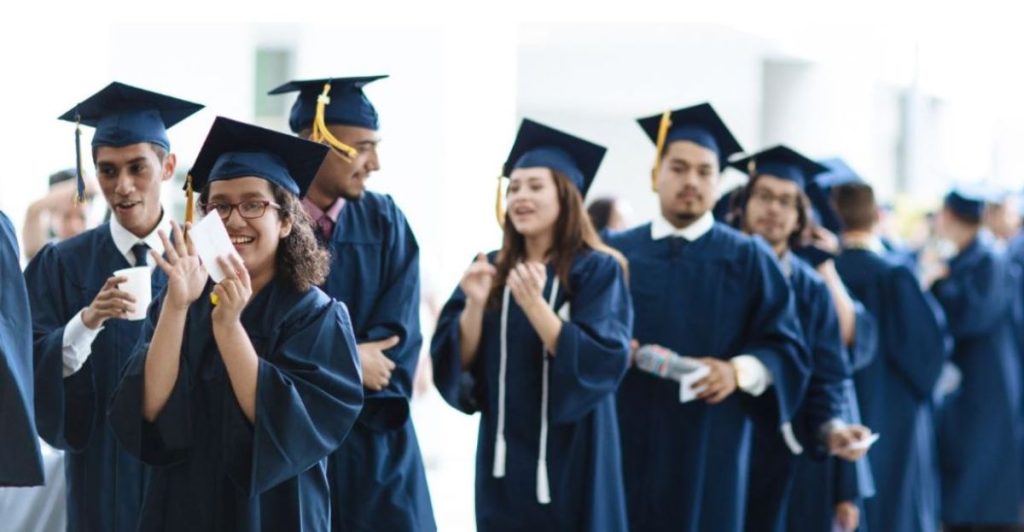
References
Arnold, K., Fleming, S., DeAnda, M., Castleman, B., & Wartman, K. L. (2009). The summer flood: The invisible gap among low-income students. Thought & Action, 25, 23-34.
Bourdieu, P. (1997). The forms of capital. In A.H. Halsey, H. Lauder, P. Brown, & A.S. Wells (Eds.) Education: culture, economy and society. Oxford University Press.
Castro, E. L. (2013). Racialized readiness for college and career: Toward an equity-grounded social science of intervention programming. Community College Review, 41(4), 292-310. https://doi.org/10.1177/0091552113504291
Coburn, C. E., & Penuel, W. R. (2016). Research–practice partnerships in education: Outcomes, dynamics, and open questions. Educational Researcher, 45(1), 48–54. https://doi.org/10.3102/0013189X16631750
Coburn C. E., Penuel W. R., Geil K. (2013). Research-practice partnerships at the district level: A new strategy for leveraging research for educational improvement. William T. Grant Foundation. Retrieved December 15th, 2023, from https://rpp.wtgrantfoundation.org/wp-content/uploads/2019/10/Research-Practice-Partnerships-at-the-District-Level.pdf
Creswell, J. W. (2013). Qualitative inquiry and research design: Choosing among five approaches (3rd ed.). SAGE Publications, Inc.
Dulabaum, N. L. (2016). Barriers to academic success: A qualitative study of African American and Latino male students. Innovation Showcase, 11(6). Retrieved December 15th, 2023, from https://www.league.org/innovation-showcase/barriers-academic-success-qualitative-study-african-american-and-latino-male
Dumais, S. A., & Ward, A. (2010). Cultural capital and first-generation college success. Poetics, 38(3), 245-265. https://doi.org/10.1016/j.poetic.2009.11.011
Duncheon, J. C., & Relles, S. R. (2019). Brokering college opportunity for first-generation youth: The role of the urban high school. American Educational Research Journal, 56(1), 146–177. https://doi.org/10.3102/0002831218788335
Freeman, K. (1997). Increasing African Americans’ participation in higher education: African American high-school students perspectives. Journal of Higher Education, 68(5), 523-550. https://doi.org/10.1080/00221546.1997.11778996
Gay, G. (2002). Preparing for culturally-responsive teaching. Journal of Teacher Education, 53(2), 106-116. https://doi.org/10.1177/0022487102053002003
Holland, N. E. (2017). Beyond conventional wisdom: Community cultural wealth and the college
knowledge of African American youth in the United States. Race Ethnicity and Education, 20(6), 796-810. https://doi.org/10.1080/13613324.2016.1150823
Hooker, S. & Brand, B. (2010). College knowledge: a critical component of college and career readiness. New Directions for Youth Development. (2010):75-85. https://doi.org/10.1002/yd.364
Jacobi, M. (1991). Mentoring and undergraduate academic success: A literature review. Review of Educational Research, 61(4), 505–532. https://doi.org/10.3102/00346543061004505
Kurlaender, M., Reed, S., & Hurtt, A. (2019, August). Improving college readiness: A research summary and implications for practice [Policy brief, report]. Policy Analysis for
California Education. Retrieved December 15th, 2023 from https://edpolicyinca.org/publications/improving-college-readiness-research-summary-and-implications-practice
Lareau, A., & Horvat, E. M. (1999). Moments of social inclusion and exclusion: Race, class and cultural capital in family-school relationships. Sociology of Education, 72(1), 37–53. https://doi.org/10.2307/2673185
Levine, A., & Nidiffer, J. (1996). Beating the Odds: How the Poor Get to College. Jossey-Bass, Inc.
McDonough, P. M. (1997). Choosing colleges: How social class and schools structure opportunity. State University of New York Press.
Milner IV, H. R. (2007). Race, culture, and researcher positionality: Working through dangers seen, unseen, and unforeseen. Educational Researcher, 36(7), 388-400. https://doi.org/10.3102/0013189X07309471
Mokher, C. G. (2020). Reforming transitions from high School to higher education: Evidence on the effectiveness of college readiness policies. In L. Perna (Ed.), Higher Education: Handbook of Theory and Research (Vol. 36, pp. 47–103). Springer, Cham. https://doi.org/10.1007/978-3-030-44007-7_5
Perez, W.Y., Knox, J., & Harris-Wilkerson, E. (2021). Expanding the equity conversation for pathways to college: A literature review of college access and college readiness research 2014-2021. Metropolitan Center for Research on Equity and the Transformation of Schools. Retrieved December 15, 2023 from https://steinhardt.nyu.edu/metrocenter/research-evaluation/research/literature-review-college-access-and-readiness-research
Putnam, R. D. (1995). Bowling alone: America’s declining social capital. Journal of Democracy, 6(1), 65-78. https://doi.org/10.1353/jod.1995.0002
Putnam, R.D. (1993, April 1). The prosperous community: Social capital and public life. The American Prospect. Retrieved December 15th, 2023 from
https://prospect.org/infrastructure/prosperous-community-social-capital-public-life/
Abrahamson, E. D., Puzzar, C., Ferro, M. S., & Bailey, S. (2019). Peer mentors’ experiences and perceptions of mentoring in undergraduate health and sports science programmes. Journal of Pedagogical Research, 3(2), 21-37. https://doi.org/10.33902/JPR.2019254158
Quartz, K.H., Dimagiba, A., Jacobo, S., Murillo, M.A., & Amador, V. (2020). Creating persistent community: The challenge of aligning supports for first-generation college-going students. UCLA Center for Community Schooling. Retrieved December 15, 2023 from https://communityschooling.gseis.ucla.edu/creating-persistent-community/
Quartz, K. H., Murillo, M. A., Trinchero, B., Neri, R. C., & Jacobo, S. (2019). Framing, supporting, and tracking college-for-all reform. The High School Journal, 102(2), 159-182. https://www.jstor.org/stable/26757722
Quartz, K. H., Weinstein, R. S., Kaufman, G., Levine, H., Mehan, H., Pollock, M., Priselac, J. Z., & Worrell, F. C. (2017). University-partnered new school designs: Fertile ground for research–practice partnerships. Educational Researcher, 46(3), 143-146. https://doi.org/10.3102/0013189X17703947
Rall, R.M. (2016). Forgotten students in a transitional summer: Low-income racial/ethnic minority students experience the summer melt. Journal of Negro Education, 85(4), 462-479. https://doi.org/10.7709/jnegroeducation.85.4.0462
Saldana, J. (2013). The Coding Manual for Qualitative Researchers (2nd ed.). SAGE Publications Ltd.
Stanton-Salazar, R.D. (2001). Manufacturing hope and despair: The school and kin support networks of U.S.-Mexican youth. Teachers College Press.
Stanton-Salazar, R. D., & Spina, S. U. (2000). The network orientations of highly resilient urban minority youth: A network-analytic account of minority socialization and its educational implications. The Urban Review, 32, 227-261. https://doi.org/10.1023/A:1005122211864
Valenzuela, A. (1999). Subtractive schooling: U.S.-Mexican youth and the politics of caring. State University of New York Press.
Yosso, T. J. (2005). Whose culture has capital? A critical race theory discussion of community cultural wealth. Race Ethnicity and Education, 8(1), 69-91. https://doi.org/10.1080/1361332052000341006
Welton, A.D., & Martinez, M.A. (2014). Coloring the college pathway: A more culturally responsive approach to college readiness and access for students of color in secondary schools. The Urban Review, 46, 197–223. https://doi.org/10.1007/s11256-013-0252-7
About the Authors
Jonathan Oyaga is a first generation, Latino aspiring educator studying education at UCLA. His passion for education drives him to be a middle school special education teacher. Realizing that education can be used to transform families and communities, he currently pursues his studies in addition to organizing California aspiring educators as president of the Student California Teachers Association. He aspires to become an educator, but to also work as a community organizer and public education advocate.
Elsie Paulsen is a third-year undergraduate student double majoring in Education and Social Transformation and Public Affairs. She is a research intern at the UCLA Community School and is currently investigating the best way to support high school seniors with their transition to college as first-generation students. Elsie has a passion for public policy and has previously worked with the Anti-Defamation League on their government relations team primarily advocating for anti-hate legislation.
Sarahy Torres is a third-year undergraduate double majoring in Chicanx Studies and Education and Social Transformation. She is a research intern for the RFK UCLA Community School and co-teaches a college transition class to high school seniors. She is passionate about teaching first-generation students who come from underrepresented backgrounds. She currently serves as a state council representative for the Student California Teacher Association (SCTA) advocating for curriculum and instruction in California.
Chia Ying Wong is an undergraduate double majoring in Education and Social Transformation, as well as English. She is a passionate, aspiring educator with strong interests in education policy, special education, and frameworks promoting positive trajectories for vulnerable youths. Apart from education research, Chia Ying also enjoys serving as a Program Support Director in USAC’s Community Service Commission, and leading the Youth Empowerment Program, a student group providing after-school mentorship for diverse children.

